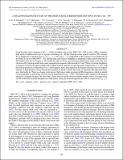A MULTIWAVELENGTH STUDY OF THE HIGH SURFACE BRIGHTNESS HOT SPOT IN PKS 1421–490
Author(s)
Godfrey, L. E. H.; Bicknell, G. V.; Lovell, J. E. J.; Jauncey, D. L.; Gelbord, Jonathan; Schwartz, D. A.; Birkinshaw, M.; Georganopoulos, Markos; Murphy, David W.; Perlman, E. S.; Worrall, D. M.; Marshall, Herman; ... Show more Show less
DownloadGodfrey-2009-A MULTIWAVELENGTH ST.pdf (589.6Kb)
PUBLISHER_POLICY
Publisher Policy
Article is made available in accordance with the publisher's policy and may be subject to US copyright law. Please refer to the publisher's site for terms of use.
Terms of use
Metadata
Show full item recordAbstract
Long Baseline Array imaging of the z = 0.663 broadline radio galaxy PKS 1421–490 reveals a 400 pc diameter high surface brightness hot spot at a projected distance of ~40 kpc from the active galactic nucleus. The isotropic X-ray luminosity of the hot spot, L 2-10 keV = 3 × 10[superscript 44] ergs s-1, is comparable to the isotropic X-ray luminosity of the entire X-ray jet of PKS 0637–752, and the peak radio surface brightness is hundreds of times greater than that of the brightest hot spot in Cygnus A. We model the radio to X-ray spectral energy distribution using a one-zone synchrotron self-Compton model with a near equipartition magnetic field strength of 3 mG. There is a strong brightness asymmetry between the approaching and receding hotspots and the hot spot spectrum remains flat (α ≈ 0.5) well beyond the predicted cooling break for a 3 mG magnetic field, indicating that the hotspot emission may be Doppler beamed. A high plasma velocity beyond the terminal jet shock could be the result of a dynamically important magnetic field in the jet. There is a change in the slope of the hotspot radio spectrum at GHz frequencies, which we model by incorporating a cutoff in the electron energy distribution at γmin ≈ 650, with higher values implied if the hotspot emission is Doppler beamed. We show that a sharp decrease in the electron number density below a Lorentz factor of 650 would arise from the dissipation of bulk kinetic energy in an electron/proton jet with a Lorentz factor Γjet gsim 5.
Date issued
2009-04Department
MIT Kavli Institute for Astrophysics and Space ResearchJournal
Astrophysical Journal
Publisher
Institute of Physics/American Astronomical Society
Citation
Godfrey, L. E. H., G. V. Bicknell, J. E. J. Lovell, D. L. Jauncey, J. Gelbord, D. A. Schwartz, H. L. Marshall, et al. “A MULTIWAVELENGTH STUDY OF THE HIGH SURFACE BRIGHTNESS HOT SPOT IN PKS 1421–490.” The Astrophysical Journal 695, no. 1 (April 1, 2009): 707–723. © 2009 American Astronomical Society.
Version: Final published version
ISSN
0004-637X
1538-4357